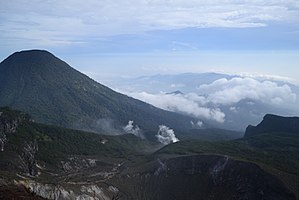
Summary
The Western Java montane rain forests ecoregion (WWF ID: IM0167) covers the montane rain forest above 1,000 meters in the volcanic mountain ridges in the west of the island of Java in Indonesia. Several mammals and bird species are found only in this ecoregion, including the Javan mastiff bat (Otomops formosus) and the Volcano mouse (Mus vulcani). Only about one-fifth of the original rainforest remains in its original state, as human pressures are encroaching on the mountain slopes.[1][2][3][4]
| Western Java montane rain forests | |
|---|---|
 | |
 Ecoregion territory (in purple) | |
| Ecology | |
| Realm | Indomalayan |
| Biome | Tropical and subtropical moist broadleaf forests |
| Geography | |
| Area | 26,342 km2 (10,171 sq mi) |
| Country | Indonesia |
| Coordinates | 7°15′S 107°45′E / 7.25°S 107.75°E |
Location and description edit
The ecoregion stretches 500 km from west to east across western and central Java. This mountainous region, historically known as Parahyangan, is only 30-80 km wide. Major volcanoes, from west to east, include Mount Salak, Mount Pangrango, Mount Guntur, Galunggung, Mount Cereme, Mount Slamet, Mount Sindoro, Mount Sumbing, and Mount Merbabu. The highest elevation is 3,428 metres (11,247 ft) at Mount Slamet. The ecoregion is completely surrounded by the Western Java rain forests ecoregion at lower elevations.[4][2]
Climate edit
The climate of the ecoregion is Tropical monsoon climate (Köppen climate classification (Am)). This climate is characterized by relatively even temperatures throughout the year (all months being greater than 18 °C (64 °F) average temperature), and a pronounced dry season. The driest month has less than 60 mm of precipitation, but more than (100-(average/25) mm. This climate is mid-way between a tropical rainforest and a tropical savannah.[5][6]
Flora and fauna edit
About 65% of the ecoregion is covered in closed forest, mostly broadleaf evergreen, an additional 20% is open forest.[3] The evergreen forest includes Artocarpus elasticus, yellow mahogany (Epicharis parasitica), langsat (Lansium parasiticum), and Planchonia valida. Common montane tree species include Lithocarpus, Quercus, and Castanopsis species, as well as laurels.[4] At higher elevations, characteristic species are heath (family Ericaceae) such as Rhododendron.
There are 64 species of mammals in the ecoregion, 16 of which are endemic. Mammals of conservation interest include the endangered Javan surili (Presbytis comata), the endangered Silvery gibbon (Hylobates moloch), and the critically endangered Javan leopard (Panthera pardus melas).[4]
Protected areas edit
Over 7% of the ecoregion is officially protected.[3] These protected areas include:
References edit
- ^ "Western Java montane rain forests". World Wildlife Federation. Retrieved March 21, 2020.
- ^ a b "Map of Ecoregions 2017". Resolve, using WWF data. Retrieved September 14, 2019.
- ^ a b c "Western Java montane rain forests". Digital Observatory for Protected Areas. Retrieved August 1, 2020.
- ^ a b c d "Western Java montane rain forests". The Encyclopedia of Earth. Retrieved August 28, 2020.
- ^ Kottek, M.; Grieser, J.; Beck, C.; Rudolf, B.; Rubel, F. (2006). "World Map of Koppen-Geiger Climate Classification Updated" (PDF). Gebrüder Borntraeger 2006. Retrieved September 14, 2019.
- ^ "Dataset - Koppen climate classifications". World Bank. Retrieved September 14, 2019.


